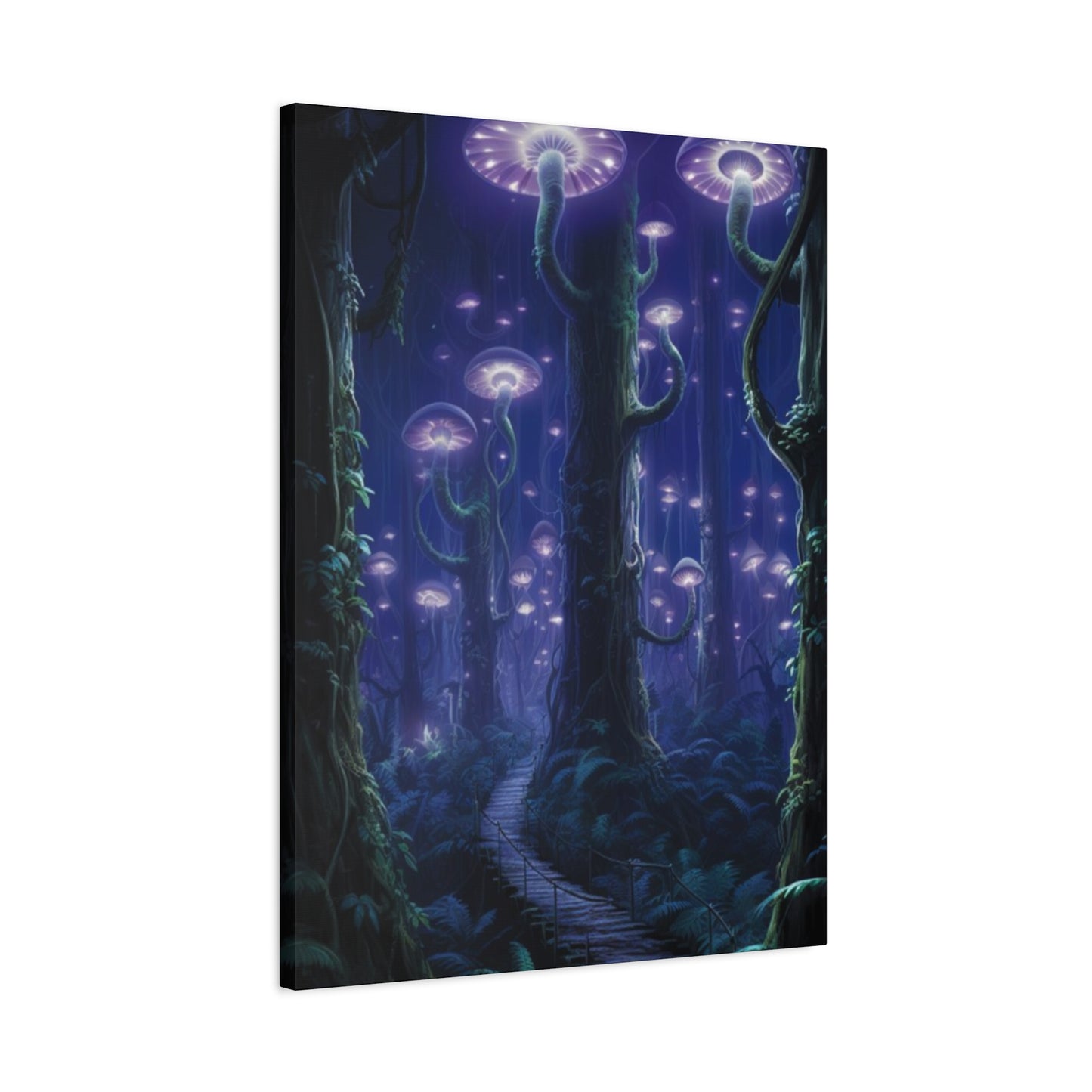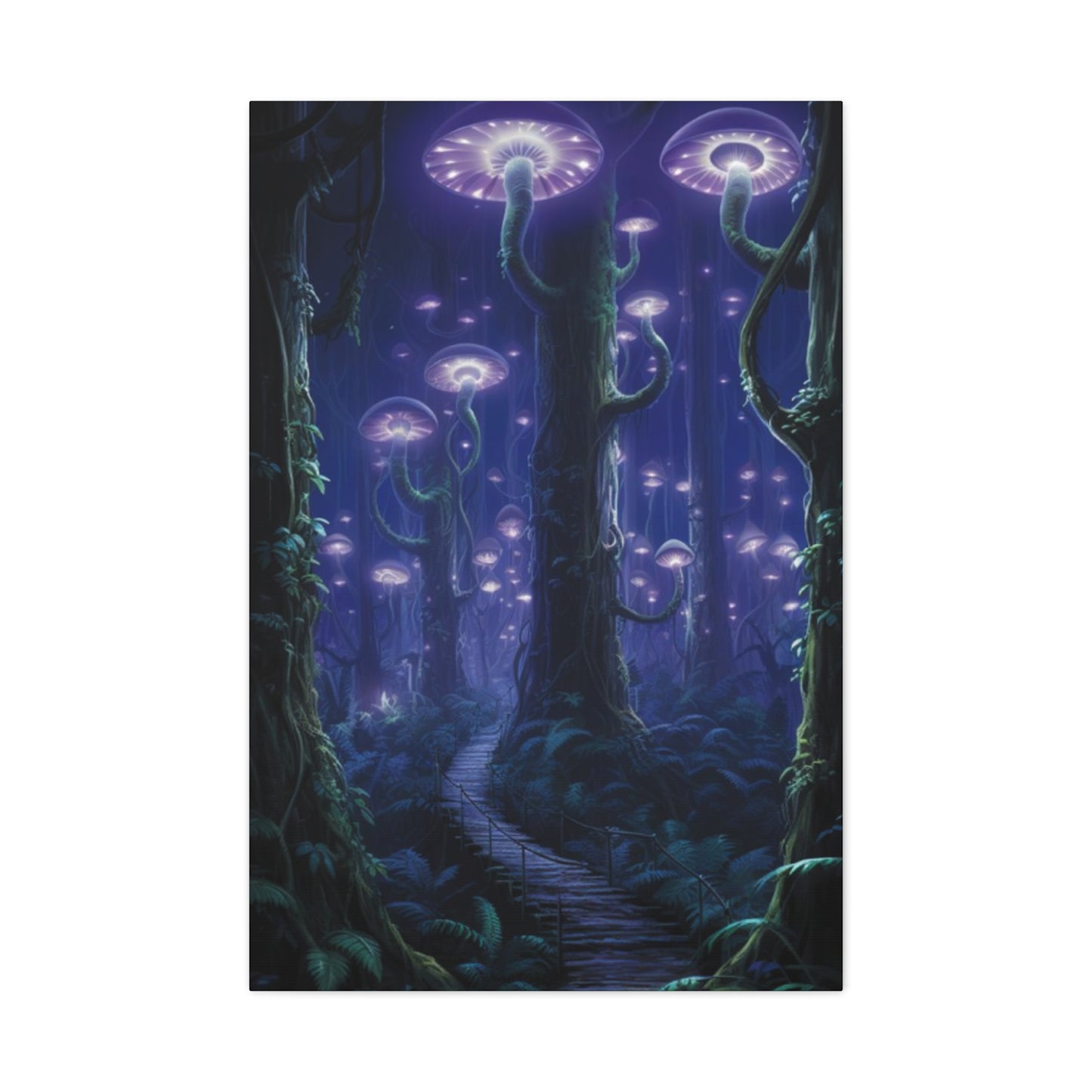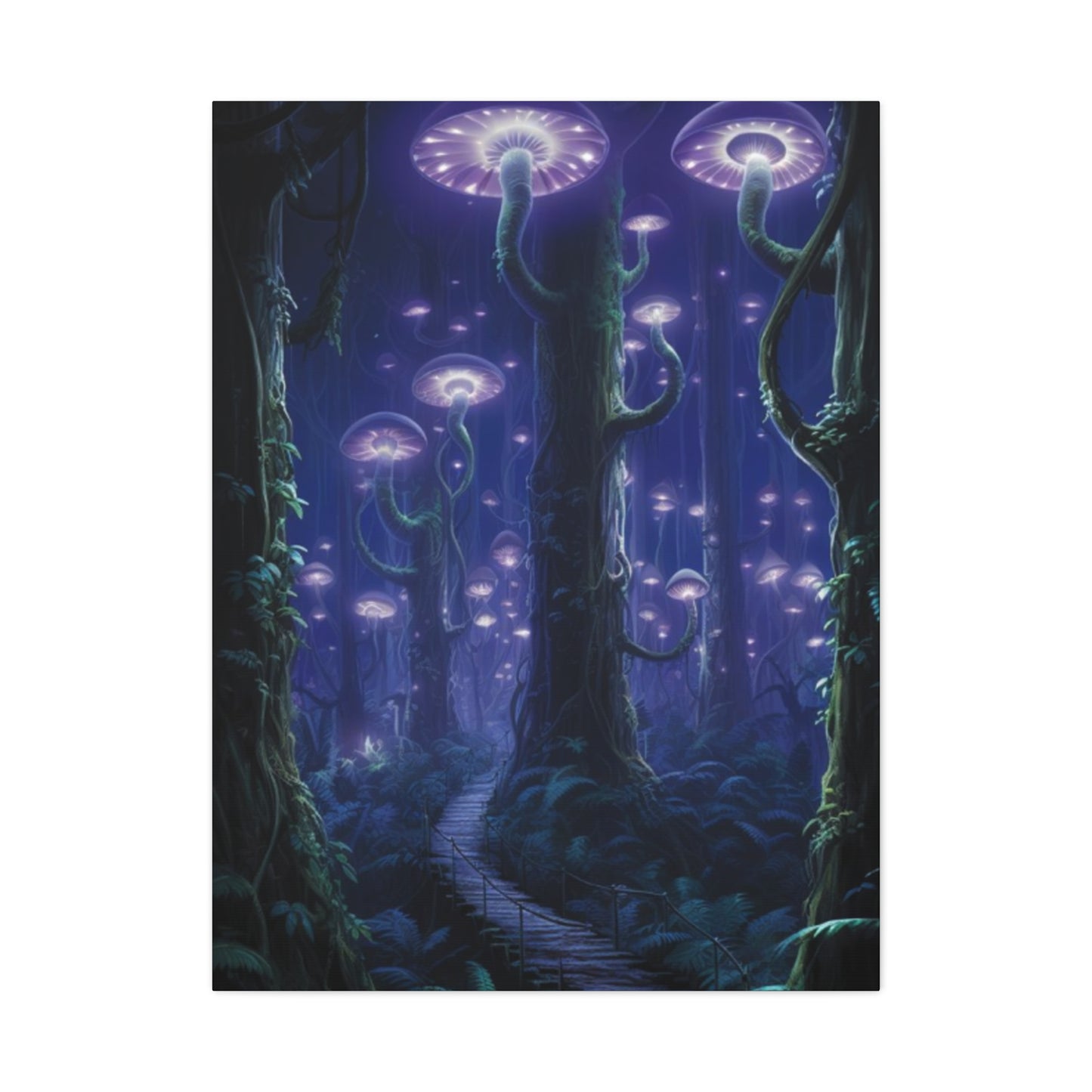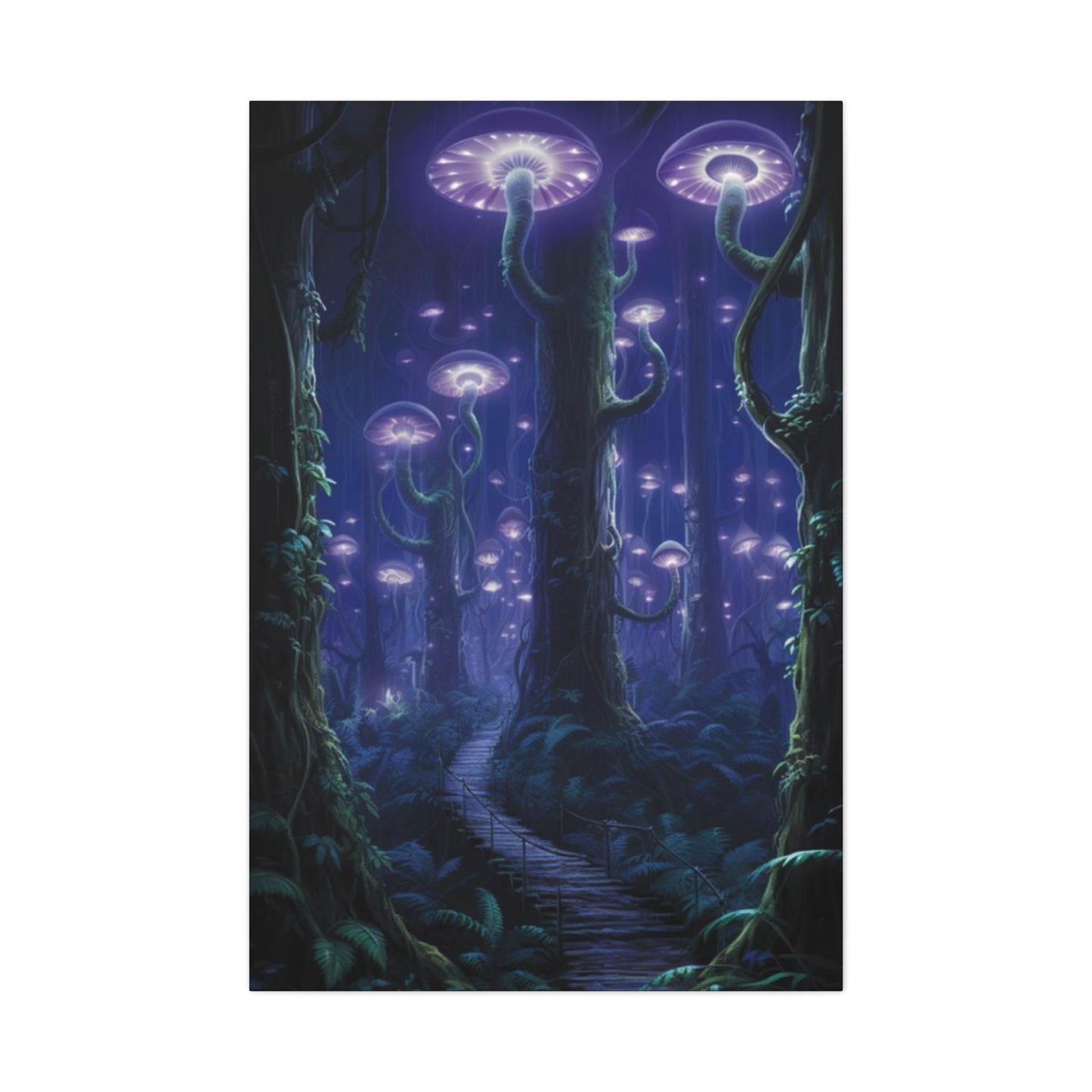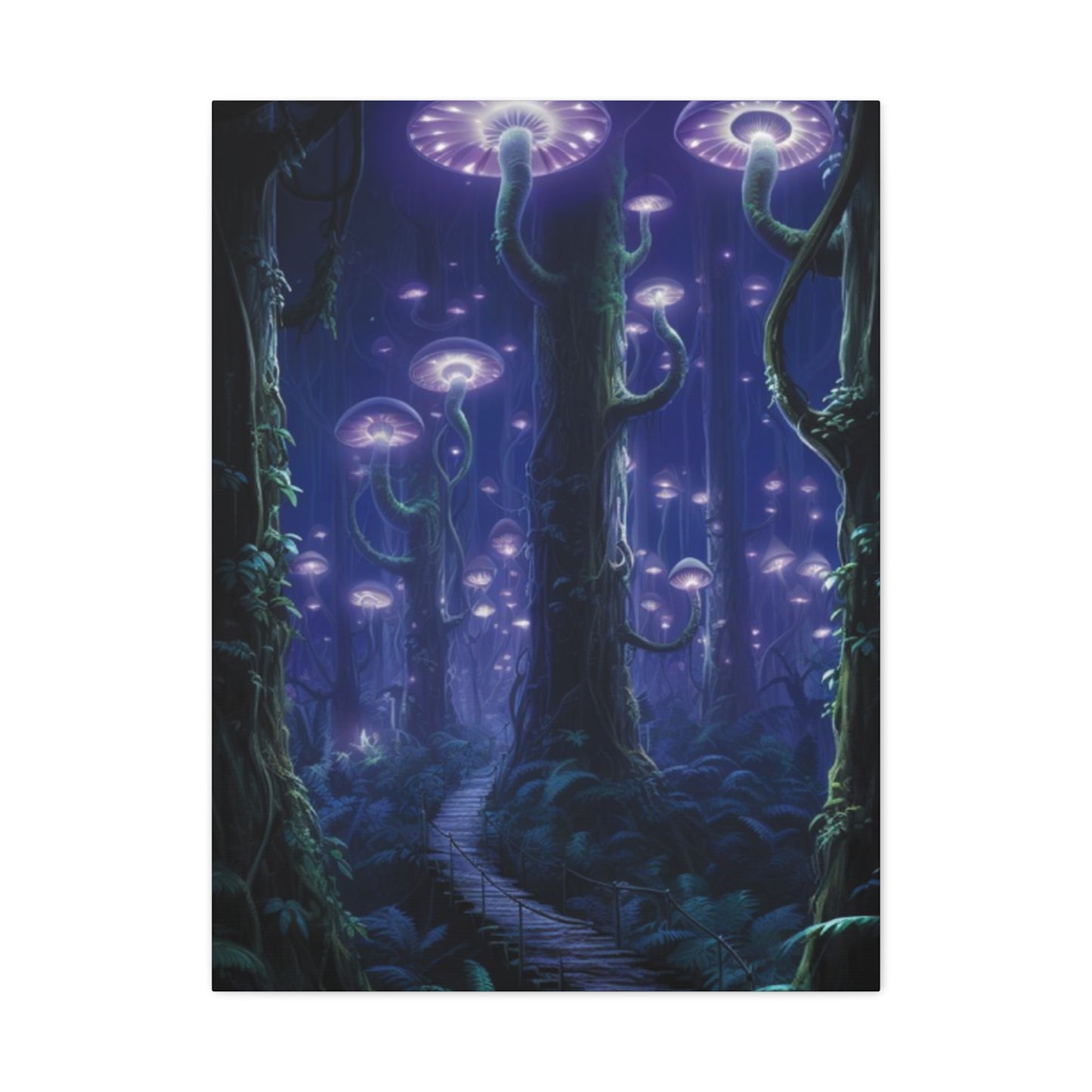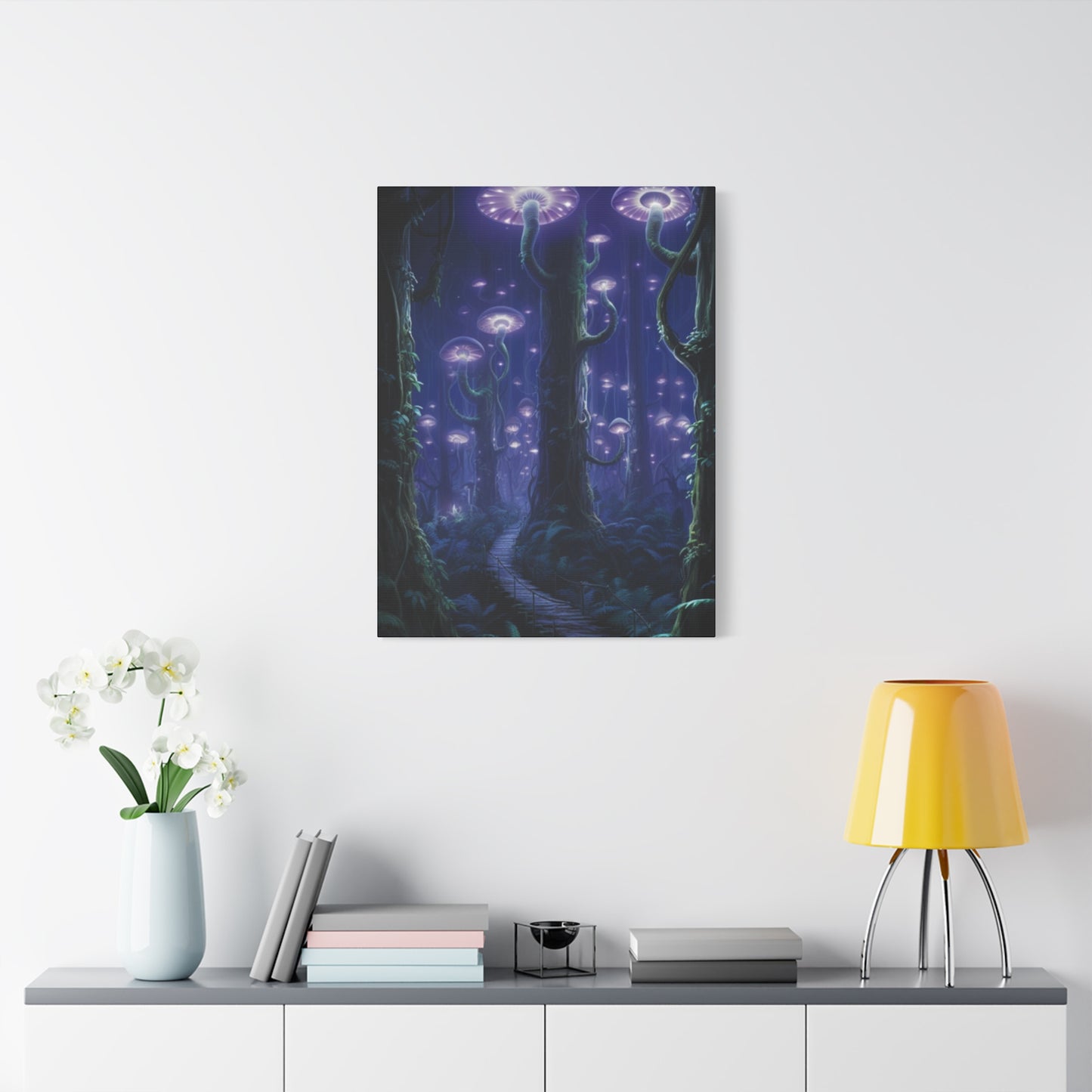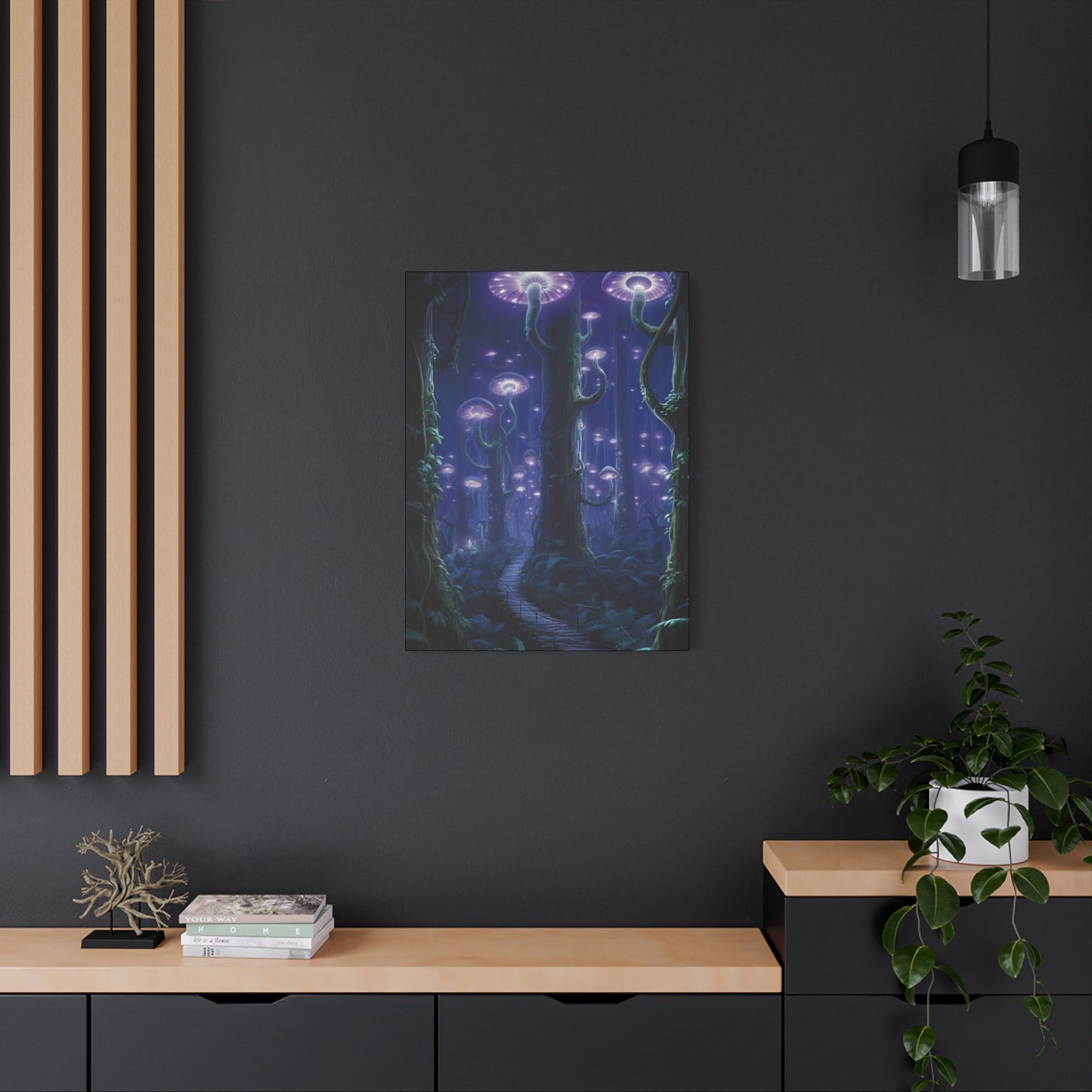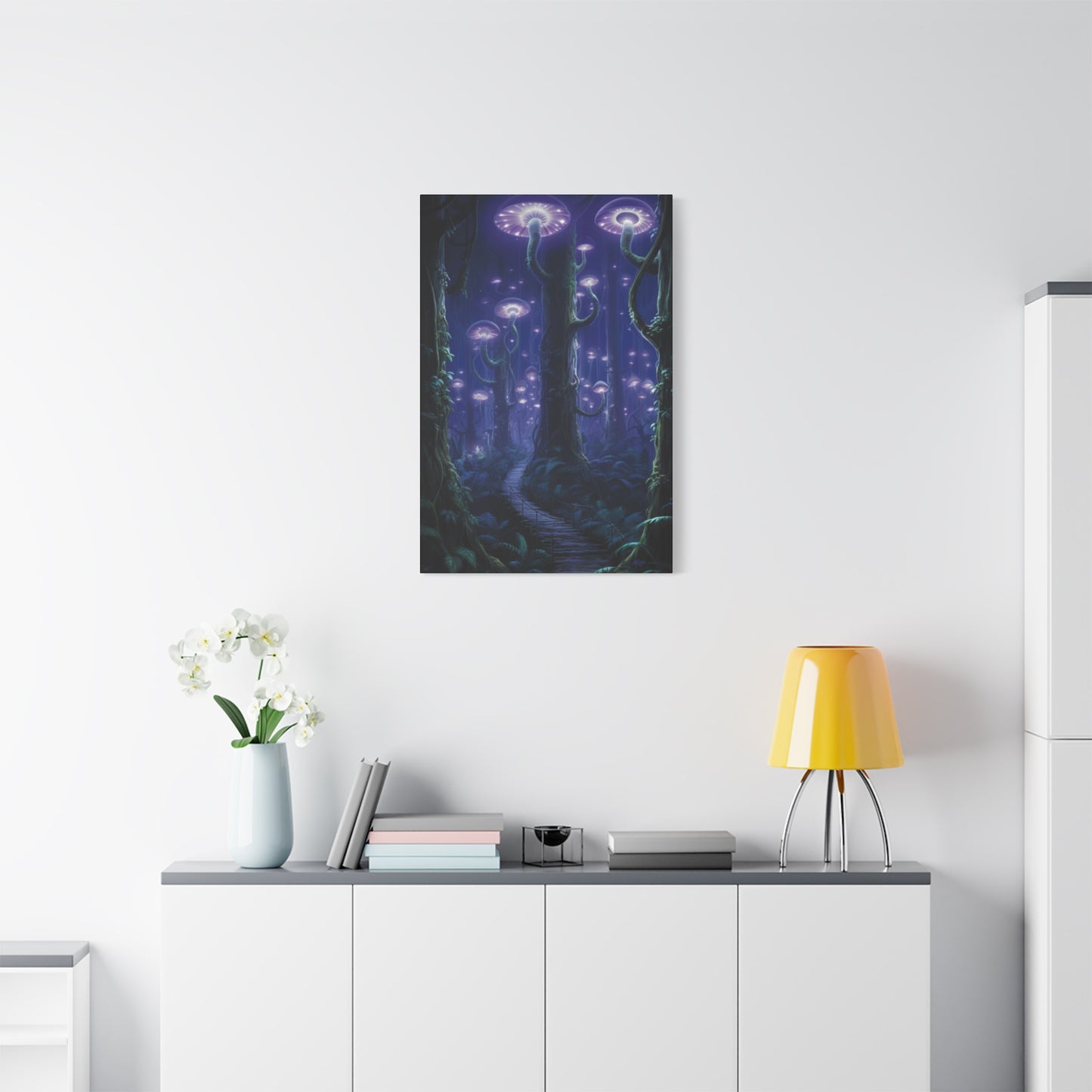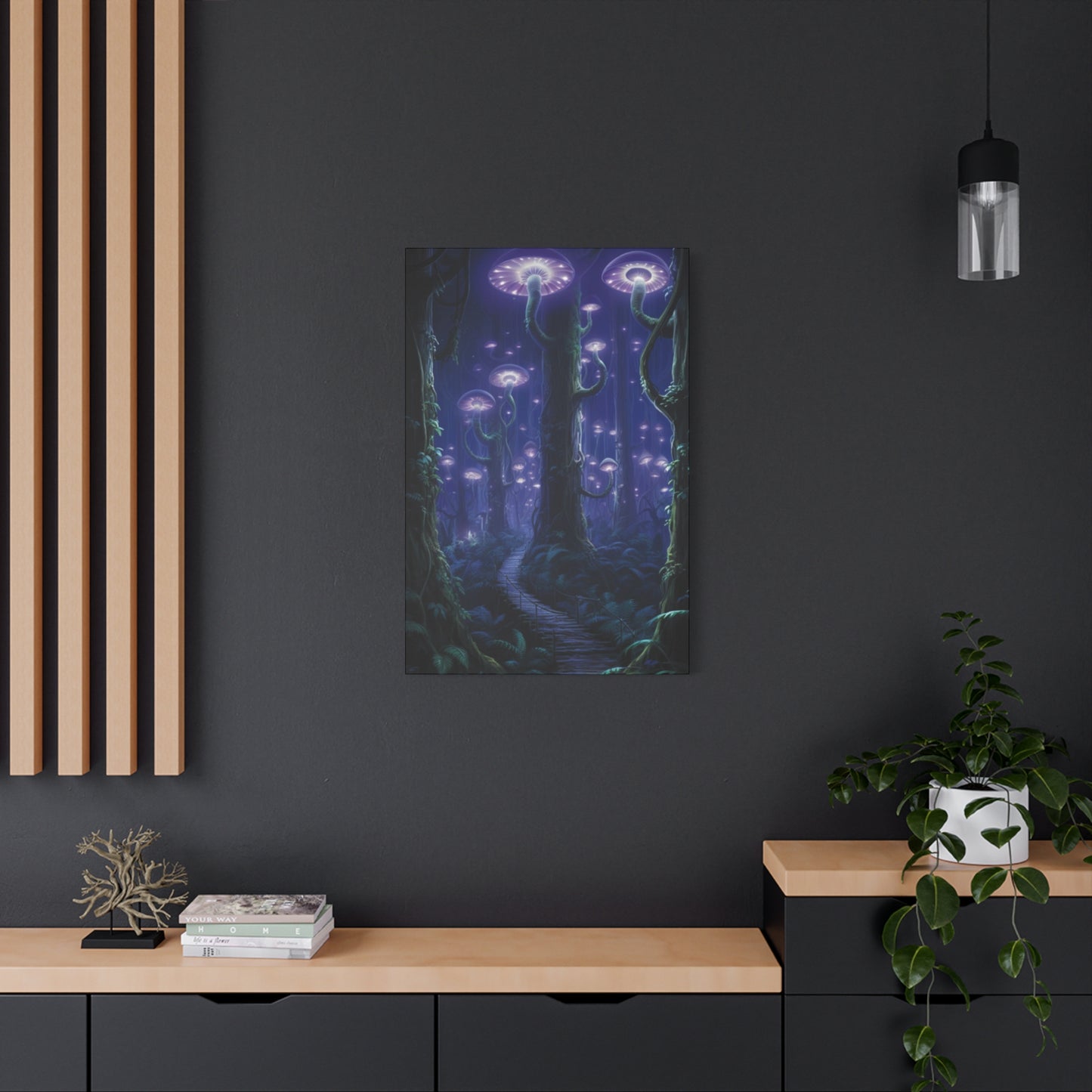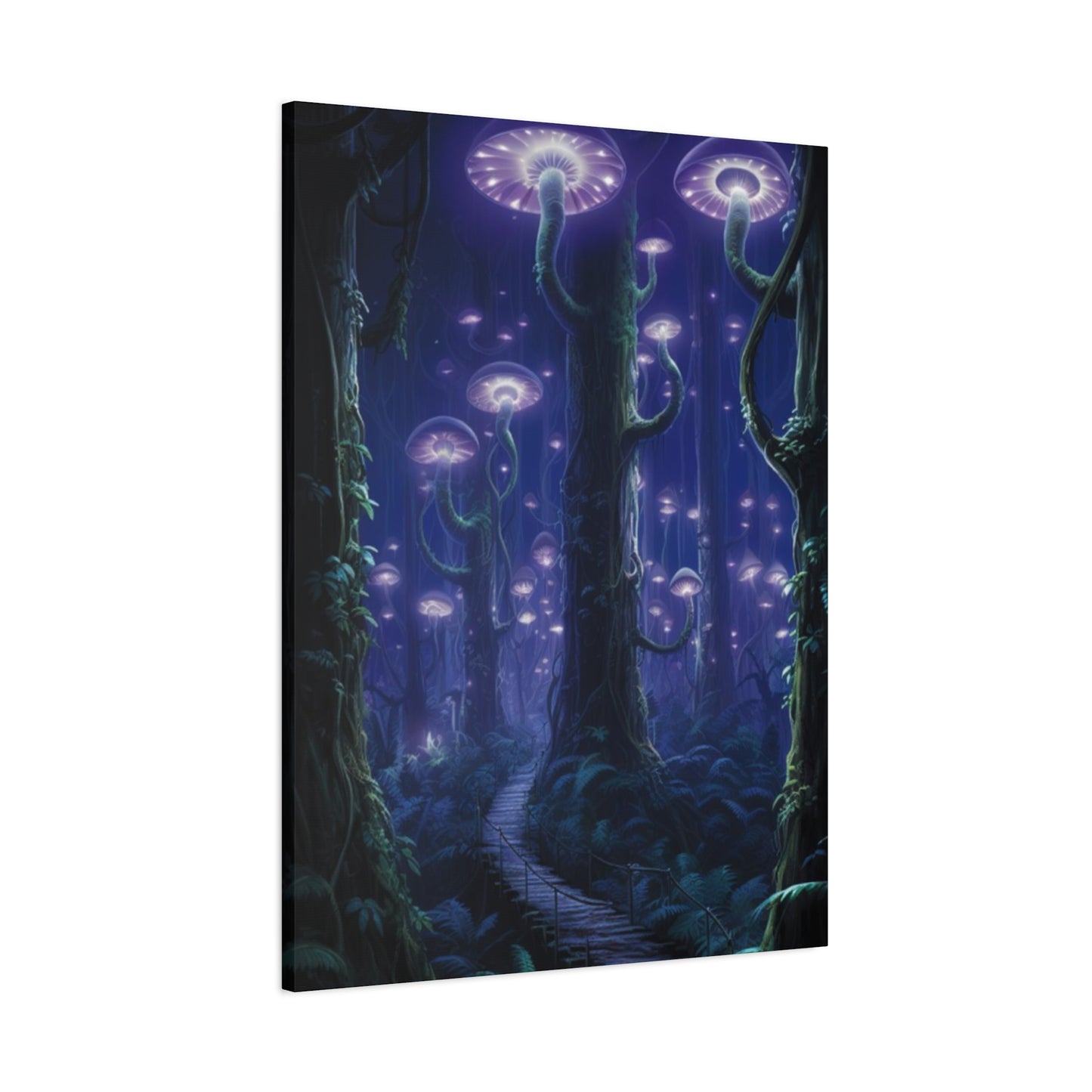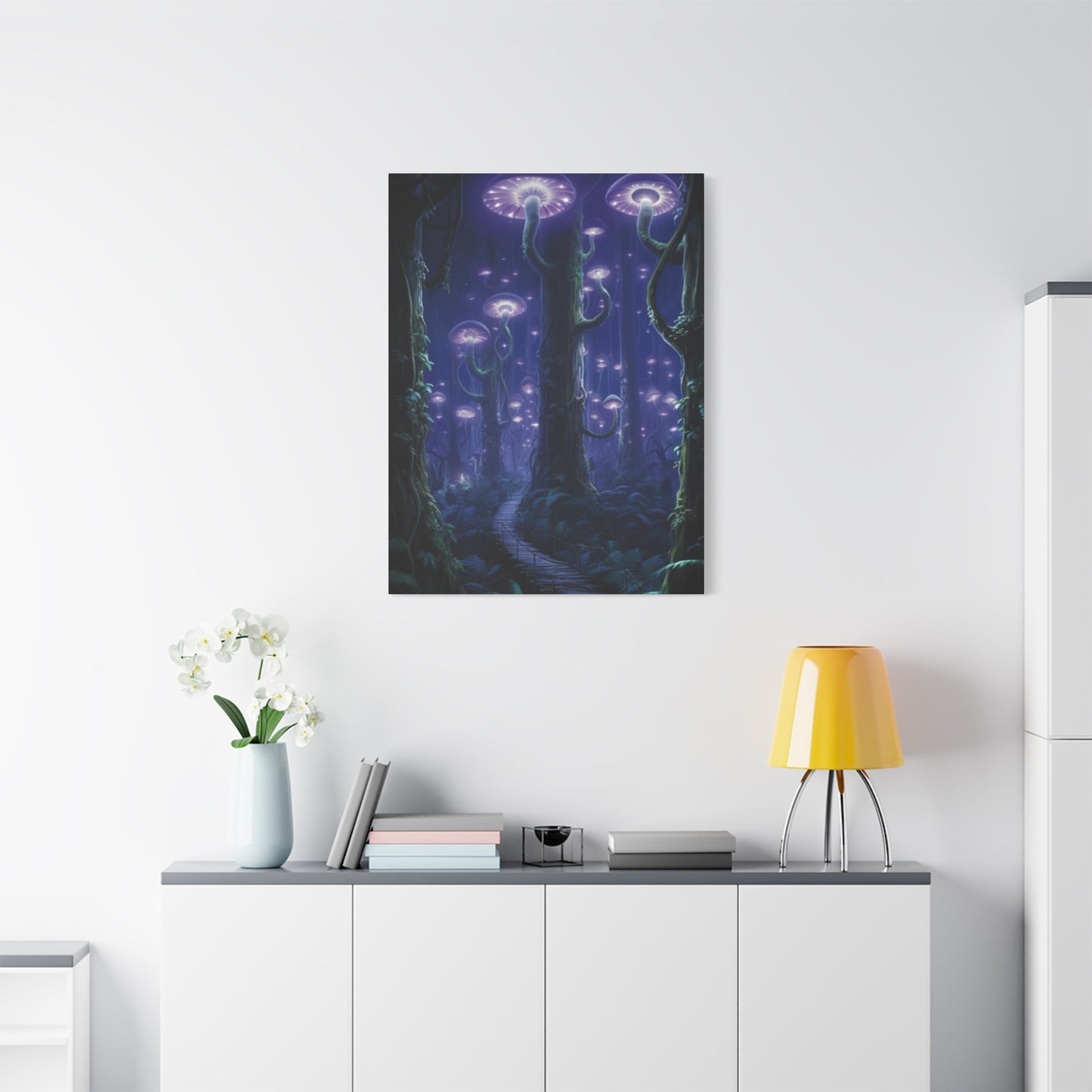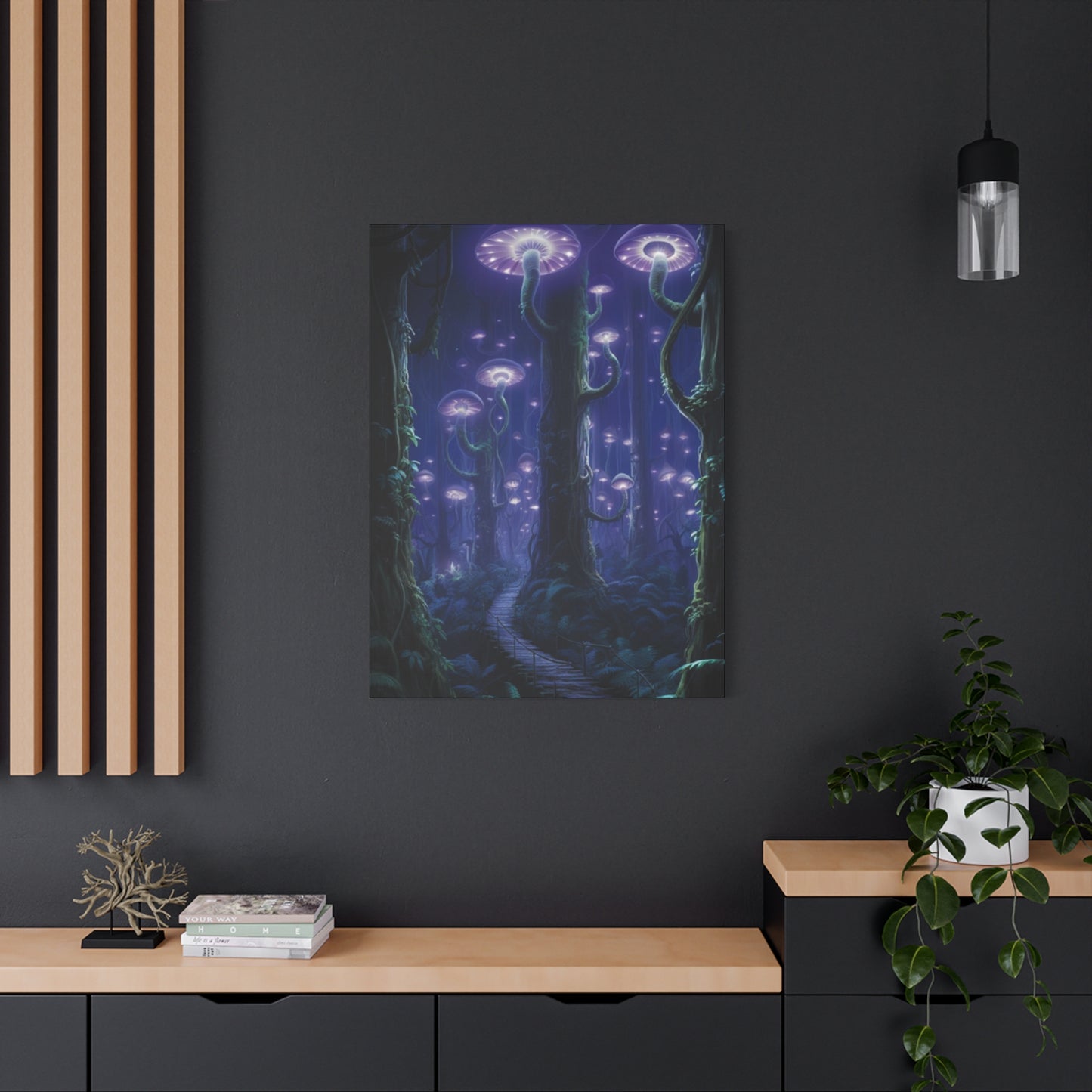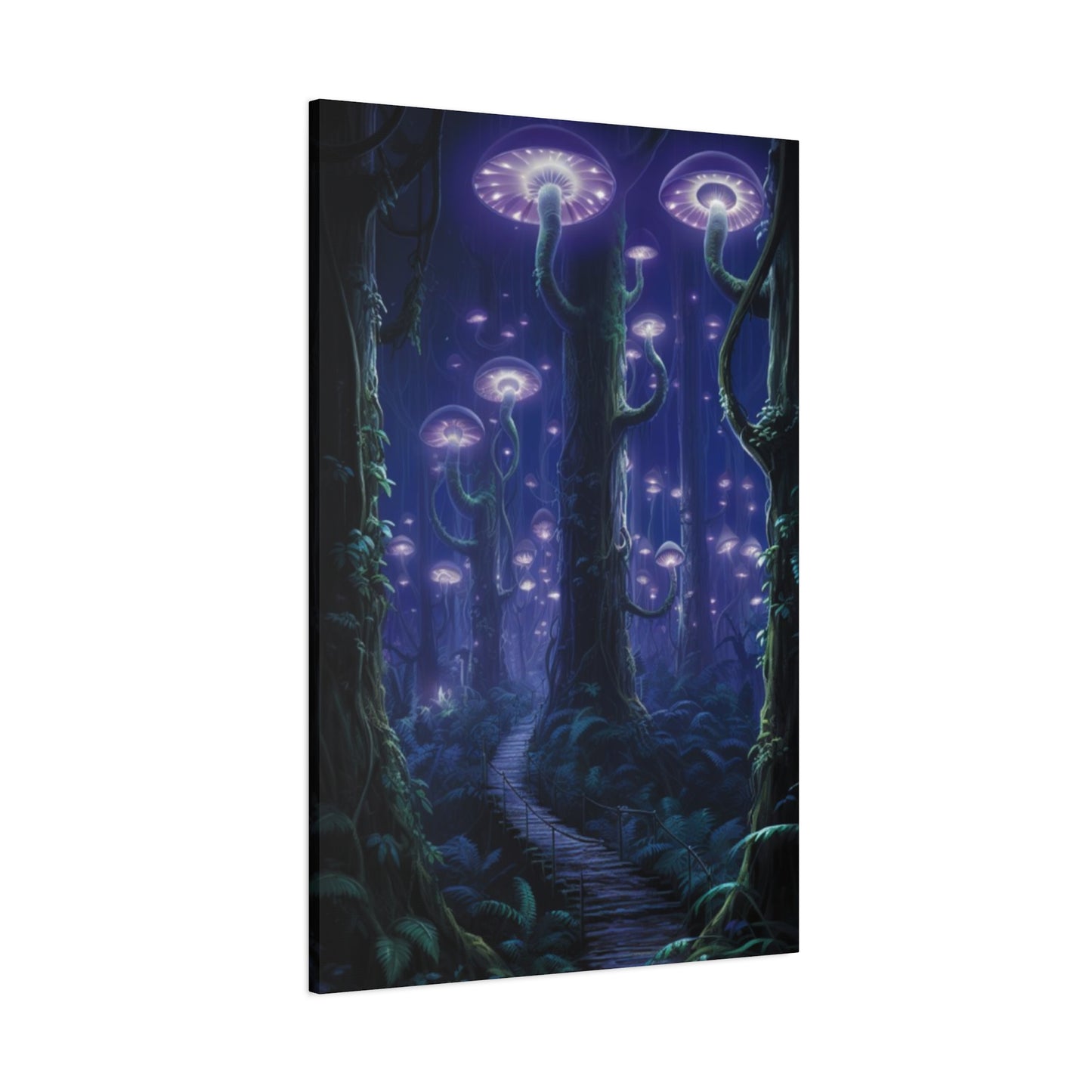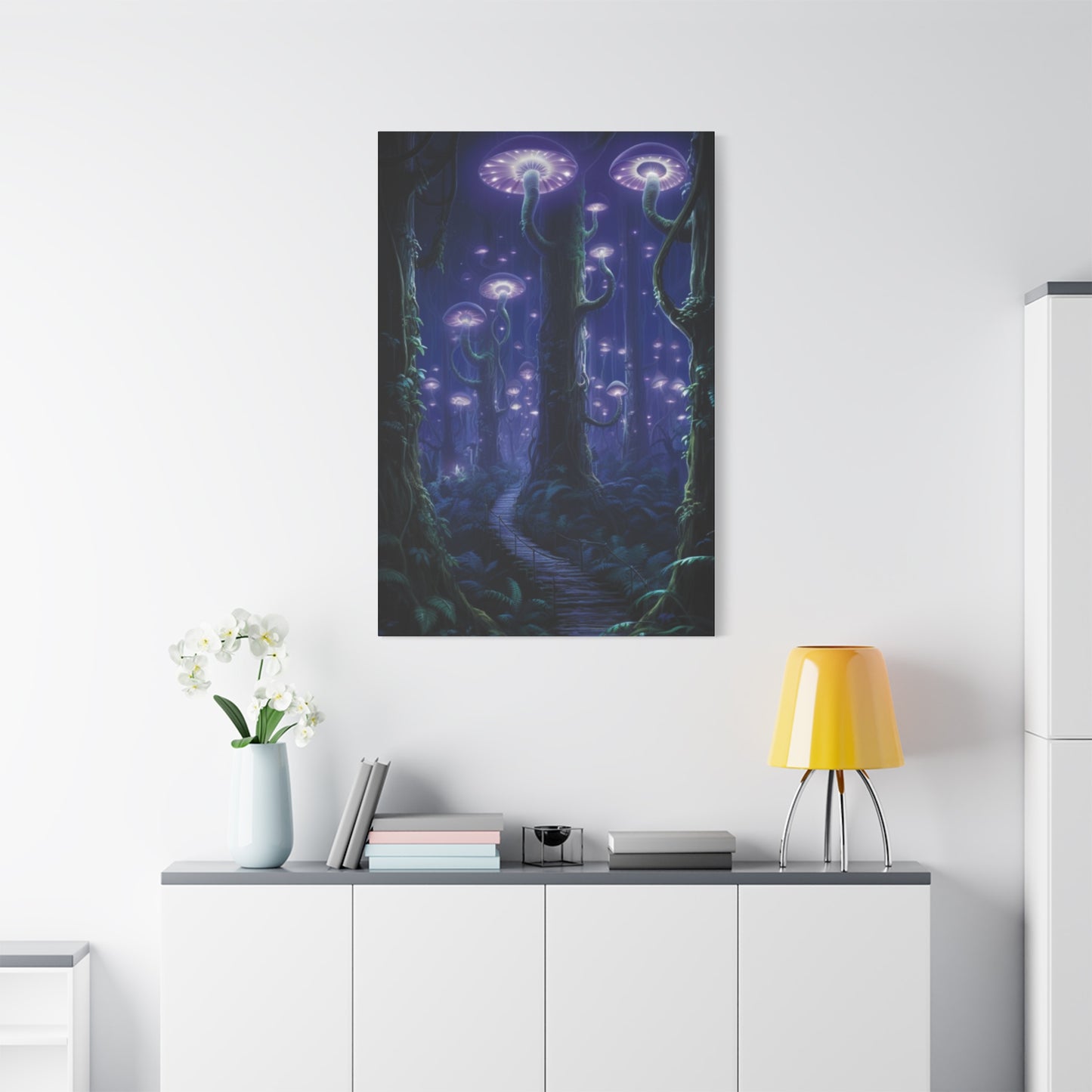Enchanting Glowing Mushroom Wall Art: Magical Forest Canvas Collection
Glowing mushroom art represents one of the most captivating trends in contemporary home decoration. These luminescent fungal creations transport viewers into mystical realms where fantasy meets reality. The ethereal quality of bioluminescent mushrooms has captured the imagination of artists and homeowners alike, creating stunning visual narratives that illuminate living areas with otherworldly beauty.
The fascination with glowing mushrooms stems from nature's own spectacular displays. Real bioluminescent fungi, such as the honey mushroom and foxfire fungus, emit natural light through chemical reactions within their cellular structures. This phenomenon has inspired countless artists to recreate these magical scenes on canvas, bringing the wonder of nature's light show directly into our homes.
When selecting glowing mushroom wall art, consider pieces that showcase different varieties of luminescent fungi. Some artwork features delicate, umbrella-shaped mushrooms with soft blue-green glows, while others depict cluster formations with vibrant purples and pinks. The diversity in mushroom shapes and colors allows for creating dynamic gallery walls that tell complete stories of enchanted forests.
The artistic interpretation of glowing mushrooms often extends beyond simple representation. Many contemporary artists incorporate abstract elements, combining realistic fungal forms with dreamlike backgrounds and atmospheric effects. These pieces serve as conversation starters and focal points that draw attention while maintaining an air of mystery and wonder.
Digital art techniques have revolutionized how artists approach glowing mushroom themes. Through careful layering and luminosity effects, creators can achieve remarkably realistic bioluminescent appearances that seem to emit actual light. This technological advancement has made high-quality mushroom art more accessible to diverse audiences seeking magical home décor solutions.
Bring Fantasy to Life with Mushroom Forest Prints
Mushroom forest prints offer an immersive experience that transports viewers into fantastical woodland realms. These comprehensive artworks typically feature entire ecosystems where glowing mushrooms serve as natural lanterns, illuminating moss-covered logs, twisted tree roots, and mysterious pathways that seem to lead to unknown adventures.
The composition of mushroom forest prints often follows principles of depth and perspective that create illusions of three-dimensional environments. Artists strategically place larger mushrooms in the foreground while smaller ones recede into misty backgrounds, creating layers that invite exploration. This technique makes rooms appear larger while providing endless details for contemplation.
Color palettes in mushroom forest artwork tend to emphasize cool tones that enhance the ethereal quality of bioluminescence. Deep forest greens serve as foundations, while electric blues, soft purples, and luminous whites create the glowing effects. Some artists incorporate warm amber tones to suggest moonlight filtering through forest canopies, adding complexity to the overall mood.
The therapeutic benefits of mushroom forest imagery cannot be overlooked. Studies in environmental psychology suggest that nature-themed artwork can reduce stress levels and promote feelings of tranquility. The soft, organic shapes of mushrooms combined with forest settings create calming environments that support relaxation and meditation practices.
Contemporary mushroom forest prints often incorporate elements from various artistic movements. Some draw inspiration from Art Nouveau's organic forms and flowing lines, while others embrace surrealist techniques that blur boundaries between reality and dreams. This fusion of styles ensures that mushroom forest art appeals to diverse aesthetic preferences while maintaining its core magical appeal.
Why Glowing Mushrooms Make Mesmerizing Wall Art
The mesmerizing quality of glowing mushroom wall art lies in its ability to combine natural beauty with supernatural elements. Unlike traditional botanical illustrations, these pieces suggest hidden worlds and secret knowledge, tapping into deep-seated human fascinations with mystery and magic. The luminescent quality creates visual interest that changes throughout the day as ambient lighting conditions shift.
Glowing mushrooms possess inherent symbolic meanings that resonate across cultures. In many traditions, mushrooms represent transformation, growth, and the connection between earth and sky. Their rapid appearance after rain showers associates them with renewal and regeneration. When depicted with bioluminescent properties, these meanings expand to include illumination, guidance, and the revelation of hidden truths.
The technical aspects of creating convincing glowing effects require sophisticated understanding of light behavior and color theory. Artists must consider how bioluminescent objects would interact with their surroundings, casting subtle reflections on nearby surfaces while maintaining their ethereal quality. This attention to detail separates exceptional mushroom art from merely decorative pieces.
Psychological research indicates that humans are naturally drawn to luminous objects, an evolutionary trait linked to our ancestors' reliance on fire and natural light sources. Glowing mushroom art triggers these deep-seated responses while providing safe, controlled exposure to luminescent imagery. This combination of attraction and comfort makes such artwork particularly effective in creating welcoming environments.
The versatility of glowing mushroom themes allows artists to explore various scales and compositions. Single mushroom studies can serve as intimate focal points, while sprawling forest scenes create immersive environments. This range ensures that glowing mushroom art can complement any architectural setting while maintaining its distinctive magical character.
The Enchanted Look: Forest Wall Art That Glows
Creating an enchanted aesthetic with forest wall art requires careful attention to both individual pieces and overall composition. Glowing forest artwork should evoke feelings of mystery and wonder while maintaining visual harmony within existing décor schemes. The key lies in balancing fantastical elements with sophisticated design principles that appeal to mature sensibilities.
Forest wall art that incorporates glowing elements typically features layered compositions where multiple light sources create complex interplays of illumination and shadow. These pieces often include moonbeams filtering through tree canopies, bioluminescent plants scattered throughout undergrowth, and reflective water surfaces that multiply and amplify light sources. Such complexity rewards careful observation while creating ever-changing visual experiences.
The enchanted forest aesthetic draws heavily from folklore and mythology, incorporating symbols and motifs that have captivated human imagination for centuries. Twisted trees with human-like faces, mysterious pathways that disappear into mist, and ancient stone structures covered in luminescent moss all contribute to narratives that suggest hidden worlds existing parallel to our own.
Contemporary interpretations of enchanted forest themes often blend traditional elements with modern artistic techniques. Digital painting allows for precise control over luminescent effects, while mixed media approaches can incorporate textural elements that enhance the tactile quality of forest environments. These innovations ensure that enchanted forest art remains relevant to contemporary audiences while honoring timeless themes.
The placement of glowing forest art requires consideration of surrounding lighting conditions and architectural features. These pieces often work best in areas where they can be appreciated during both daylight and evening hours, as changing light conditions reveal different aspects of the artwork's luminescent qualities. Strategic positioning near reading areas or meditation corners maximizes their contemplative potential.
Create a Dreamy Vibe with Glowing Nature Scenes
Glowing nature scenes possess unique abilities to establish dreamy atmospheres that promote relaxation and creative thinking. Unlike harsh artificial lighting, the soft luminescence depicted in these artworks creates gentle visual anchors that guide attention without overwhelming viewers. This quality makes them particularly suitable for bedrooms, studies, and other personal retreat areas.
The dreamy quality of glowing nature art often stems from its departure from photographic realism. Artists typically employ soft focus techniques, muted color transitions, and atmospheric perspective to create impressions rather than literal representations. This approach allows viewers to project their own interpretations and emotional responses onto the artwork, creating personalized connections that enhance the overall experience.
Color psychology plays a crucial role in establishing dreamy vibes through glowing nature scenes. Cool blues and greens suggest tranquility and peace, while soft purples and pinks evoke mystery and romance. The strategic use of complementary warm tones, such as golden yellows or amber oranges, creates visual tension that prevents the artwork from becoming too passive or monotonous.
The scale and proportion of elements within glowing nature scenes significantly impact their dreamy qualities. Oversized mushrooms or flowers can create Alice in Wonderland-like atmospheres that challenge perceptions of scale and reality. Conversely, delicate, miniature scenes invite close inspection and contemplation, fostering intimate connections between viewers and the artwork.
Layering techniques in glowing nature art contribute to its dreamy characteristics by creating depth and visual complexity. Foreground elements might be rendered with sharp detail and vibrant colors, while background elements fade into soft, luminous mists. This graduated clarity mimics how human vision works in low-light conditions, creating psychologically comfortable viewing experiences.
Perfect Prints for Cottagecore and Fairycore Decor
The cottagecore and fairycore aesthetic movements have embraced glowing mushroom wall art as essential elements for creating authentic magical atmospheres. These décor styles celebrate connections with nature, handmade crafts, and simpler ways of living, making luminescent forest imagery natural extensions of their core philosophies. The organic forms and natural themes align perfectly with cottagecore's emphasis on rural romanticism.
Cottagecore décor typically features warm, earthy color palettes that complement the cool tones often found in glowing mushroom art. This contrast creates visual interest while maintaining overall harmony. The organic shapes of mushrooms echo the curved lines found in cottage architecture and handmade crafts, creating cohesive design narratives that feel authentic and lived-in.
Fairycore aesthetics push the magical elements even further, embracing openly fantastical themes that celebrate imagination and wonder. Glowing mushroom art fits seamlessly into fairycore environments, serving as windows into otherworldly realms where magic is commonplace. The bioluminescent qualities suggest fairy lights and magical energy, supporting the movement's emphasis on enchantment and mystery.
The handmade quality valued in both cottagecore and fairycore movements can be reflected in the selection of mushroom wall art. Pieces that show visible brush strokes, textural variations, or slight imperfections communicate authenticity and human touch that mass-produced items lack. This quality alignment ensures that the artwork feels integrated rather than added as an afterthought.
Seasonal considerations play important roles in cottagecore and fairycore décor schemes. Mushroom artwork can represent autumn harvest themes, spring renewal, or summer forest explorations, depending on color choices and compositional elements. This seasonal flexibility allows for rotating displays that keep living environments fresh and aligned with natural cycles.
Mystical Forests: Add Depth to Your Walls
Mystical forest wall art creates illusions of depth that can dramatically alter the perceived dimensions of any room. Through careful use of perspective, atmospheric effects, and layered compositions, these artworks transport viewers beyond physical wall surfaces into expansive natural environments. This spatial expansion effect is particularly valuable in smaller living areas where physical space limitations restrict decorating options.
The technique of atmospheric perspective, borrowed from traditional landscape painting, plays crucial roles in creating depth within mystical forest scenes. Distant elements are rendered with cooler colors and softer edges, while foreground elements maintain warm tones and sharp details. This natural phenomenon, when skillfully reproduced in artwork, triggers psychological responses that make viewers feel as though they are looking through windows rather than at flat surfaces.
Layered composition techniques in mystical forest art often feature multiple planes of visual information. Foreground elements might include detailed mushroom studies or moss-covered logs, middle grounds could show tree trunks and undergrowth, while backgrounds fade into mysterious depths filled with glowing elements. This complexity rewards extended viewing while creating ever-changing focal points as attention shifts between layers.
The psychological impact of depth-creating wall art extends beyond mere visual tricks. Research in environmental psychology suggests that access to natural views, even simulated ones, can improve cognitive function and reduce stress levels. Mystical forest art that successfully creates depth impressions may provide similar benefits while adding elements of wonder and imagination that pure landscape photography cannot match.
Color temperature variations throughout mystical forest compositions enhance depth perception while creating emotional narratives. Warm foreground colors suggest safety and familiarity, while cool background tones evoke mystery and exploration. The gradual transition between these temperatures guides viewers' eyes through the composition while establishing emotional journeys from comfort to adventure.
Bioluminescent Art for Home Décor
Bioluminescent art represents a fascinating intersection between scientific observation and artistic imagination. While true bioluminescence occurs through complex biochemical processes in living organisms, artists have developed numerous techniques for recreating these effects in static artworks. The result is home décor that captures the wonder of natural light production while providing reliable, permanent illumination effects.
The scientific accuracy of bioluminescent art varies significantly between artists and styles. Some creators conduct extensive research into actual bioluminescent organisms, studying their light patterns, colors, and environmental contexts. Others take more liberties with scientific reality, using bioluminescent themes as starting points for purely imaginative creations. Both approaches have merit, depending on the intended use and audience for the artwork.
Contemporary digital art techniques have revolutionized the creation of convincing bioluminescent effects. Through careful layering of luminous glazes, strategic use of complementary colors, and sophisticated understanding of how light behaves in natural environments, artists can create artworks that seem to emit actual light. These techniques require significant skill and experience but produce results that can transform ordinary rooms into extraordinary environments.
The placement of bioluminescent art within home décor schemes requires careful consideration of existing lighting conditions and color palettes. These pieces often work best as focal points that draw attention without competing with other decorative elements. The inherent drama of bioluminescent imagery means that a little can go a long way in terms of visual impact.
The therapeutic potential of bioluminescent art should not be underestimated. The soft, organic light patterns found in these artworks can promote relaxation and contemplation while providing visual interest that prevents monotony. Many viewers report feeling calmer and more creative when surrounded by bioluminescent imagery, suggesting real psychological benefits beyond mere aesthetic appeal.
Wall Art for Fantasy Lovers and Nature Dreamers
Fantasy lovers and nature dreamers represent overlapping audiences with shared appreciation for imagery that transcends ordinary reality. Wall art that combines fantastical elements with natural themes speaks to both groups' desires for escapism and connection with greater mysteries. The key to creating successful pieces for these audiences lies in balancing imaginative elements with believable natural details.
Fantasy genre conventions often emphasize magical ecosystems where ordinary natural laws are suspended or modified. Glowing mushrooms fit perfectly into these worlds, serving as natural light sources that eliminate the need for torches or artificial illumination. This practical magic appeals to fantasy enthusiasts who appreciate internally consistent world-building and logical magical systems.
Nature dreamers typically seek artwork that celebrates the inherent wonder and complexity of natural systems. While they may not embrace openly fantastical elements, they often appreciate artistic interpretations that reveal hidden aspects of natural beauty. Bioluminescent mushrooms provide perfect bridges between reality and imagination, being both scientifically accurate and visually magical.
The emotional resonance of fantasy nature art often stems from its ability to provide hope and wonder in an increasingly urbanized world. These pieces suggest that magic still exists in natural environments, encouraging viewers to maintain connections with outdoor experiences and environmental conservation. This messaging appeals to both fantasy fans and nature enthusiasts who share concerns about environmental preservation.
The technical execution of fantasy nature art requires balancing detailed naturalistic rendering with imaginative embellishments. Successful pieces maintain enough scientific accuracy to satisfy nature lovers while incorporating enough magical elements to engage fantasy fans. This balancing act requires significant artistic skill and deep understanding of both natural systems and fantasy genre conventions.
Glowing Mushroom Art for Cozy Reading Nooks
Reading nooks benefit enormously from carefully selected wall art that enhances the contemplative and escapist qualities of literary experiences. Glowing mushroom art provides perfect companions for reading areas, offering visual interest that doesn't distract from printed pages while creating atmospheric backgrounds that support literary journeys. The soft, organic forms and gentle luminescence complement the quiet intimacy of reading experiences.
The psychological compatibility between mushroom imagery and reading activities stems from shared associations with growth, transformation, and hidden knowledge. Books and mushrooms both emerge from seemingly simple beginnings to reveal complex internal structures and profound influences on their environments. This symbolic resonance creates unconscious connections that enhance the reading experience while providing visual metaphors for literary discoveries.
Color considerations for reading nook art must balance visual interest with eye comfort during extended reading sessions. Cool blues and greens provide calming backgrounds that won't cause eye strain, while soft warm tones can create cozy atmospheres without overwhelming brightness. The key lies in selecting pieces with sufficient contrast to maintain visual interest while avoiding harsh transitions that might prove distracting.
The scale of mushroom art in reading nooks should complement the intimate nature of these areas without overwhelming the limited visual field. Medium-sized pieces work well as focal points behind reading chairs, while smaller artworks can be clustered to create gallery walls that reward contemplation during reading breaks. The goal is to enhance the environment without competing with books for attention.
Seasonal rotation of mushroom art can keep reading nooks fresh and aligned with changing moods throughout the year. Spring pieces might emphasize growth and renewal themes, while autumn selections could focus on harvest and transformation motifs. This flexibility ensures that reading environments remain inspiring and supportive of ongoing literary adventures.
Nature, but Make It Magic: Forest Canvas Ideas
The concept of magical nature represents a growing trend in contemporary art that seeks to reveal the extraordinary aspects of ordinary natural phenomena. Forest canvas ideas that embrace this philosophy often feature familiar natural elements enhanced with subtle supernatural qualities that challenge viewers' perceptions while maintaining believable natural foundations. This approach appeals to audiences seeking both escapism and deeper connections with natural environments.
Magical forest canvases typically employ lighting effects that suggest otherworldly influences on familiar landscapes. Sunbeams might carry unusual colors, shadows could reveal mysterious shapes, and reflections in water might show different scenes than their sources. These subtle impossibilities create cognitive tensions that engage viewers' imaginations while avoiding obviously fantastical elements that might break the spell of believability.
The artistic techniques for creating magical forest effects have evolved significantly with digital art technologies. Artists can now achieve precise control over lighting, atmosphere, and special effects that would have been impossible with traditional media alone. However, the most successful pieces typically combine digital techniques with traditional artistic principles to maintain organic, hand-crafted qualities that purely digital work often lacks.
Composition strategies for magical forest canvases often emphasize discovery and exploration themes. Pathways that curve out of sight suggest continued journeys beyond the frame, while partially hidden elements invite closer inspection. These compositional devices transform passive viewing experiences into active exploration that rewards extended attention and repeated observation.
The symbolic vocabulary of magical forests draws from deep cultural traditions that span multiple civilizations and historical periods. Ancient trees represent wisdom and continuity, flowing water suggests purification and change, and hidden clearings evoke sacred grounds and secret meetings. Contemporary artists tap into these universal symbols while adding personal interpretations that speak to modern concerns and aspirations.
The Allure of Luminescent Forests in Home Décor
Luminescent forests possess unique decorative qualities that distinguish them from traditional landscape art. The presence of internal light sources creates dynamic visual experiences that change throughout the day as ambient lighting conditions shift. During bright daylight hours, these artworks might appear relatively subtle, while evening and night viewing reveals their full luminous potential, providing homes with artwork that literally lights up after dark.
The practical benefits of luminescent forest décor extend beyond aesthetic considerations to include functional lighting aspects. Well-positioned pieces can provide gentle ambient lighting that reduces the need for harsh artificial illumination during evening hours. This natural lighting alternative creates more comfortable environments for relaxation while reducing energy consumption and supporting circadian rhythm maintenance.
The scale flexibility of luminescent forest themes allows for diverse decorating applications. Large-scale pieces can serve as dramatic focal points that transform entire rooms, while smaller works can provide intimate lighting accents for specific areas. Series of related pieces can create comprehensive environmental themes that unify multiple rooms while maintaining visual coherence throughout living areas.
The technological aspects of creating convincing luminescent effects in printed artwork require sophisticated printing techniques and specialized materials. High-quality reproductions often employ metallic inks, fluorescent pigments, or specialized substrates that enhance the luminous qualities of the original artwork. These technical considerations significantly impact the final visual results and long-term durability of the pieces.
The cultural significance of luminescent forests in contemporary home décor reflects broader trends toward biophilic design and reconnection with natural environments. As urban living becomes increasingly prevalent, artwork that brings natural elements indoors serves essential psychological functions by maintaining connections with organic forms, natural lighting patterns, and seasonal cycles that support human well-being.
How to Style Glowing Mushroom Prints in Any Room
Styling glowing mushroom prints requires consideration of existing décor elements, lighting conditions, and the intended mood for each particular room. These versatile artworks can adapt to various design schemes while maintaining their distinctive magical character, but successful integration depends on thoughtful planning and strategic placement decisions that enhance rather than compete with surrounding elements.
Living room applications for glowing mushroom prints often work best when the artwork serves as a conversation piece that draws attention without overwhelming seating arrangements. Placement above sofas or fireplace mantels provides natural focal points that benefit from the inherent drama of luminescent imagery. The key lies in ensuring adequate viewing distances that allow appreciation of fine details while maintaining comfortable conversation dynamics.
Bedroom styling with mushroom prints should emphasize their calming and dreamlike qualities. Placement near headboards can create intimate reading environments, while larger pieces on opposite walls can provide visual depth that makes rooms feel more expansive. The soft, organic forms and cool color palettes typically found in mushroom art support restful environments that promote healthy sleep patterns.
Kitchen and dining areas present unique opportunities for mushroom print placement, as these culinary environments share thematic connections with fungal subjects. However, placement decisions must consider practical factors such as heat, humidity, and cleaning requirements that might affect artwork longevity. Strategic positioning away from cooking areas while maintaining visual connections can provide thematic coherence without risking damage.
Bathroom styling with mushroom prints can create spa-like environments that support relaxation and self-care routines. The natural moisture resistance of properly treated prints makes them suitable for these applications, while their organic themes complement the cleansing and renewal functions of bathroom environments. Careful attention to ventilation and direct water exposure ensures long-term preservation.
Fungi with Flair: Statement Wall Art Ideas
Statement wall art featuring fungi subjects requires bold compositional choices and confident execution that commands attention while maintaining sophisticated aesthetic appeal. Unlike decorative artwork that blends quietly into backgrounds, statement pieces demand prominent placement and supporting design elements that enhance their dramatic impact while avoiding visual competition from surrounding décor.
The scale considerations for fungi statement art typically favor larger formats that can hold their own against architectural elements and furniture arrangements. Oversized mushroom studies can create intimate encounters with natural subjects that might otherwise go unnoticed, while panoramic forest scenes can establish comprehensive environmental themes that transform entire rooms into magical landscapes.
Color strategy for fungi statement pieces often emphasizes dramatic contrasts and saturated tones that ensure visual prominence while maintaining harmony with existing color schemes. Bold complementary relationships, such as electric blues against warm oranges, create vibrant tensions that energize environments, while monochromatic approaches can provide sophisticated subtlety that rewards closer inspection.
The artistic style selection for statement fungi art should reflect the overall design personality of the hosting environment. Contemporary abstract interpretations work well in modern settings, while realistic botanical illustrations suit traditional décor schemes. Mixed media approaches that combine painting techniques with photographic elements can bridge different style preferences while maintaining unified artistic visions.
The lighting design for fungi statement art requires careful planning to ensure optimal viewing conditions throughout different times of day. Strategic placement of accent lighting can enhance luminescent effects while preventing glare that might interfere with detailed appreciation. Natural light exposure should be managed to prevent fading while maximizing the dynamic qualities that change with varying illumination conditions.
From Forest Floor to Gallery Wall
The transformation of natural forest floor discoveries into sophisticated gallery wall presentations requires curatorial vision that balances scientific accuracy with artistic interpretation. This process involves selecting, organizing, and presenting fungi-themed artwork in ways that create cohesive visual narratives while maintaining individual piece integrity and overall aesthetic harmony.
Gallery wall composition for mushroom art typically benefits from varied scales and formats that create visual rhythm while avoiding monotonous repetition. Mixing detailed studies with broader environmental scenes, incorporating different color palettes, and varying frame styles can create dynamic presentations that reward extended viewing while maintaining unified thematic coherence throughout the collection.
The height and spacing considerations for mushroom gallery walls should accommodate comfortable viewing angles while creating appropriate visual relationships between individual pieces. Standard gallery practices suggest eye-level placement for primary pieces, with supporting works arranged to guide attention through the composition while maintaining adequate white space for visual breathing room.
The educational potential of forest floor gallery walls can be enhanced through thoughtful selection of scientifically accurate species representations alongside artistic interpretations. Including identification information, habitat details, and ecological relationships can transform decorative displays into learning environments that support ongoing nature education while maintaining aesthetic appeal.
The seasonal evolution of gallery wall presentations allows for rotating displays that keep environments fresh while exploring different aspects of fungi themes throughout the year. Spring compositions might emphasize growth and emergence, while autumn arrangements could focus on harvest and decomposition cycles that complete natural narratives from forest floor to artistic presentation.
Adding a Touch of Wonder with Mushroom Wall Art
Wonder, as an emotional response to unexpected beauty or mystery, represents the core appeal of mushroom wall art in contemporary home décor. Unlike more conventional botanical subjects, mushrooms possess inherent qualities of mystery and transformation that naturally evoke wonder while maintaining connections to familiar natural environments. This combination makes them ideal subjects for creating magical atmospheres without resorting to obviously fantastical imagery.
The psychological mechanisms that trigger wonder responses include novelty, complexity, and perceived vastness or transcendence. Mushroom art effectively employs all these elements through unusual forms, intricate structural details, and suggestions of hidden worlds existing beneath ordinary surfaces. This multifaceted appeal ensures broad audience engagement while supporting repeated viewing experiences that continue to reveal new details.
The placement strategies for wonder-inducing mushroom art should consider optimal viewing conditions that maximize emotional impact while integrating smoothly into daily living patterns. Surprise placements, such as pieces discovered around corners or in unexpected alcoves, can heighten wonder responses, while more prominent positions ensure regular exposure that maintains magical atmosphere throughout living environments.
The size relationships between mushroom subjects and their presentations can dramatically affect wonder responses. Macro-scale renderings that reveal minute details invisible to casual observation can create intimate encounters with natural complexity, while large-scale environmental scenes can provide immersive experiences that transport viewers into magical realms filled with luminescent surprises.
The artistic style choices for wonder-inducing mushroom art should balance realistic accuracy with imaginative interpretation that suggests hidden depths and secret knowledge. Techniques such as selective focus, atmospheric perspective, and strategic color enhancement can reveal extraordinary aspects of ordinary subjects while maintaining believable natural foundations that support sustained emotional engagement.
Magical Mood Lighting with Glowing Prints
Glowing prints serve dual functions as both decorative artwork and ambient lighting solutions that can dramatically influence room atmospheres throughout different times of day. Unlike static art pieces, these luminescent works provide dynamic environmental elements that respond to changing natural light conditions while maintaining consistent magical qualities that enhance living environments with otherworldly charm.
The technical aspects of achieving convincing glowing effects in printed artwork require specialized techniques and materials that go beyond conventional printing methods. Metallic inks, fluorescent pigments, and specially formulated substrates can enhance luminescent qualities while ensuring long-term durability and color stability. These technical considerations significantly impact both initial costs and long-term satisfaction with the artwork investment.
The strategic placement of glowing prints for optimal mood lighting effects requires understanding how different rooms are used throughout daily cycles and seasonal changes. Evening reading areas benefit from soft, warm glows that support comfortable illumination without causing eye strain, while social areas might benefit from more dramatic lighting effects that encourage conversation and create memorable atmospheric experiences.
The color temperature considerations for mood lighting artwork must balance aesthetic appeal with psychological comfort and practical functionality. Cool blues and greens provide calming environments suitable for relaxation and meditation, while warmer tones create cozy atmospheres that encourage social interaction and creative activities. The key lies in matching lighting moods with intended room functions and personal preferences.
The integration of glowing print lighting with existing electrical systems can enhance overall environmental control while reducing energy consumption. Strategic positioning can reduce reliance on harsh artificial lighting during evening hours, while maintaining sufficient illumination for necessary activities. This sustainable approach to lighting design supports both environmental consciousness and enhanced living quality.
Glowing Mushroom Art for Bedrooms and Meditation Areas
Bedrooms and meditation areas require carefully selected artwork that supports rest, contemplation, and spiritual practices while maintaining visual interest that prevents monotony. Glowing mushroom art provides ideal solutions for these environments through soft luminescent qualities that promote relaxation while offering gentle focal points for contemplative practices and peaceful sleep preparation.
The sleep science behind bedroom art selection emphasizes the importance of avoiding overstimulating imagery that might interfere with natural circadian rhythms and healthy sleep patterns. Mushroom art with soft, organic forms and cool color palettes naturally supports restful environments while providing sufficient visual interest to prevent stark, institutional atmospheres that might feel uncomfortable or unwelcoming.
Meditation area applications for glowing mushroom art often focus on pieces that reward extended contemplation while supporting mindfulness practices. The organic, flowing forms found in mushroom subjects provide excellent focal points for breathing exercises and visualization techniques, while their luminescent qualities suggest inner illumination and spiritual growth themes that resonate with meditative traditions.
The positioning strategies for bedroom and meditation mushroom art should consider viewing angles from various postures and activities typical to these environments. Placement visible from bed positions can provide gentle focal points for pre-sleep contemplation, while meditation area positioning should accommodate seated viewing during formal practice sessions as well as casual appreciation during daily activities.
The size and scale considerations for contemplative mushroom art typically favor medium formats that provide adequate detail for extended observation without overwhelming intimate environments. Pieces should be large enough to serve as effective focal points while remaining proportional to room dimensions and compatible with other essential furnishings and equipment needed for rest and meditation activities.
Fairytale Forest Vibes in Canvas Form
Fairytale forest themes in canvas art tap into deep cultural narratives that span centuries of storytelling traditions while adapting to contemporary aesthetic sensibilities. These magical woodland scenes often feature glowing mushrooms as key elements that establish otherworldly atmospheres where ordinary natural laws are suspended and wonderful adventures become possible through artistic imagination.
The visual vocabulary of fairytale forests draws from established literary and cinematic traditions that have shaped collective understanding of magical woodland environments. Twisted trees with character-filled forms, mysterious pathways that disappear into misty depths, and enchanted clearings where magical beings might gather all contribute to narrative richness that transforms wall art into windows to parallel worlds filled with wonder and possibility.
The color palettes associated with fairytale forest aesthetics often emphasize ethereal qualities through strategic use of pastels, luminous highlights, and atmospheric effects that suggest supernatural lighting conditions. These dreamlike color relationships create environments that feel removed from everyday reality while maintaining enough natural reference points to remain psychologically accessible and emotionally engaging.
The compositional techniques for effective fairytale forest canvases frequently employ depth and perspective strategies that invite viewers to imagine themselves within the scenes rather than merely observing from outside. Winding paths, partially obscured destinations, and layered vegetation create immersive experiences that encourage exploration and discovery while supporting the escapist functions that fairytale imagery serves in contemporary home environments.
The symbolic elements commonly found in fairytale forest art often carry deeper meanings related to personal growth, transformation, and the journey toward self-discovery. Ancient trees represent wisdom and continuity, flowing streams suggest purification and change, while glowing mushrooms serve as guides or markers along spiritual and emotional journeys that resonate with viewers' own life experiences and aspirations.
Why Bioluminescent Themes Are Trending in Wall Art
The current popularity of bioluminescent themes in wall art reflects broader cultural trends toward biophilic design, environmental consciousness, and the desire for meaningful connections with natural phenomena in increasingly urbanized living environments. As people spend more time indoors and in artificial environments, artwork that celebrates natural wonders provides essential psychological connections to organic systems and processes.
The scientific fascination with bioluminescence has grown dramatically as researchers discover new examples of naturally light-producing organisms and better understand the biochemical mechanisms that create these effects. This increased knowledge has filtered into popular culture, creating broader awareness and appreciation for bioluminescent phenomena that artists have translated into compelling visual experiences for home decoration.
The technological capabilities that enable convincing reproduction of bioluminescent effects have evolved significantly with advances in digital art software, printing techniques, and specialized materials. Contemporary artists can now achieve levels of luminous realism that were previously impossible, resulting in artwork that successfully captures the magical qualities of natural bioluminescence while remaining practical for home display applications.
The psychological appeal of bioluminescent themes stems from their ability to suggest mystery, wonder, and hidden depths within familiar natural environments. This combination of accessibility and transcendence provides ideal foundations for artwork that enriches daily living experiences while supporting imaginative and spiritual development through regular exposure to images that celebrate natural magic and beauty.
The market demand for bioluminescent wall art has grown substantially as consumers seek alternatives to mass-produced decorative items that lack meaningful connections to natural systems and processes. These specialized artworks provide unique decorative solutions that reflect personal values related to environmental appreciation while creating distinctive home environments that stand apart from conventional decorating approaches.
Nature Meets Imagination in Glowing Forest Decor
The intersection of naturalistic accuracy with imaginative interpretation creates unique opportunities for glowing forest décor that satisfies both scientific curiosity and artistic appreciation. These hybrid approaches often feature recognizable natural elements enhanced with subtle fantastical qualities that suggest hidden dimensions within familiar forest environments while maintaining believable ecological foundations.
The artistic challenge of balancing natural accuracy with imaginative enhancement requires sophisticated understanding of both scientific principles and aesthetic considerations. Successful pieces typically begin with careful observation of actual forest environments and bioluminescent organisms before introducing creative elements that amplify natural wonder without contradicting fundamental biological and ecological relationships.
The educational potential of nature-imagination fusion artwork extends beyond pure decoration to include informal science education that can spark interest in actual natural phenomena and environmental conservation. Viewers who develop appreciation for artistic interpretations of glowing forests may become more motivated to seek out real natural experiences and support conservation efforts that protect the habitats where such wonders actually occur.
The technical execution of nature-imagination fusion requires mastery of both realistic rendering techniques and fantastical special effects that enhance rather than overwhelm natural foundations. Digital art tools provide unprecedented capabilities for achieving this balance, allowing artists to layer realistic environmental details with carefully controlled luminescent effects that appear naturally integrated rather than artificially imposed.
The audience appeal of nature-imagination artwork spans diverse demographics, from science enthusiasts who appreciate accurate natural details to fantasy fans who enjoy imaginative embellishments. This broad appeal makes such artwork particularly valuable for public areas and shared living environments where multiple viewers with different interests and preferences must be accommodated while maintaining unified aesthetic coherence.
Creating Immersive Environments with Mushroom Canvas Art
Immersive environments using mushroom canvas art require strategic planning that considers how multiple pieces work together to create cohesive atmospheric experiences. Unlike single statement pieces, immersive approaches employ several coordinated artworks that surround viewers with consistent thematic elements while varying specific details to maintain visual interest and prevent monotonous repetition.
The spatial planning for immersive mushroom environments typically involves mapping out sight lines and viewing positions throughout rooms to ensure optimal placement of individual pieces. Primary focal points should capture attention immediately upon entering areas, while secondary pieces provide continuing visual interest as viewers move through and inhabit the enhanced environments during daily activities.
The thematic coordination for immersive mushroom displays often follows narrative or seasonal progressions that create temporal depth alongside spatial immersion. Artwork might progress from dawn to dusk lighting conditions, follow growth cycles from spore to mature fruiting body, or explore different habitat types from forest floor to tree canopy levels that expand viewers' understanding of fungal ecosystem roles.
The lighting integration for immersive mushroom environments requires careful coordination between artwork placement and both natural and artificial illumination sources. Strategic positioning can enhance the luminescent effects depicted in individual pieces while preventing glare or shadows that might interfere with optimal viewing. This technical attention ensures that the full immersive potential is realized throughout different times of day and seasonal lighting changes.
The psychological impact of truly immersive mushroom environments can be profound, creating alternatives to stressful urban environments that support mental health and creative thinking. Research suggests that exposure to nature imagery, especially when presented immersively, can reduce stress hormones, improve mood, and enhance cognitive function in ways that benefit both immediate comfort and long-term well-being.
Conclusion
Enchanting glowing mushroom wall art brings a whimsical touch of magic and mystery to modern interior spaces. This unique style of artwork captures the fantastical allure of illuminated fungi nestled within dreamy forest scenes, blending natural beauty with a surreal, almost fairytale-like quality. As part of a magical forest canvas collection, glowing mushroom art not only transforms plain walls into captivating visual stories but also infuses homes with imagination, wonder, and a sense of escape from the ordinary.
At the heart of this artistic trend is the ability to merge fantasy and nature in a visually compelling way. Mushrooms—especially those depicted as glowing or bioluminescent—evoke themes of enchantment, transformation, and the hidden mysteries of the forest floor. When rendered with luminous colors and shadowy forest backdrops, these elements create an immersive scene that feels otherworldly yet oddly comforting. For viewers, the artwork becomes a portal into a serene, dreamlike woodland that sparks creativity and curiosity.
The appeal of glowing mushroom wall art lies not only in its visual charm but also in its versatility. Whether you favor bold neon hues or muted earthy tones with a hint of sparkle, these pieces can adapt to a wide variety of interior styles—from eclectic and bohemian to modern, gothic, or nature-inspired themes. Hung as a statement piece above a bed, sofa, or reading nook, or arranged as part of a gallery wall, these magical forest canvases bring personality and depth to any room.
Beyond their decorative value, glowing mushroom artworks also carry symbolic meaning. Mushrooms often represent renewal, hidden growth, and the unseen forces of life that thrive in darkness. Their gentle glow suggests hope, resilience, and the magic that can be found in quiet, forgotten corners. Displaying this type of wall art can subtly reflect a personal connection to nature, fantasy, or even a journey of inner exploration.
In conclusion, enchanting glowing mushroom wall art from a magical forest canvas collection is more than just an aesthetic addition to your home—it is an invitation to wonder. These mystical pieces weave together natural elements with imaginative storytelling, offering both beauty and emotional resonance. Whether you are looking to add a spark of whimsy to your space, create a cozy retreat filled with woodland charm, or simply express a love for the surreal and the fantastical, glowing mushroom wall art delivers in every way. It reminds us that magic still exists—quietly glowing in the forests of our imagination, waiting to be brought home and shared.

















